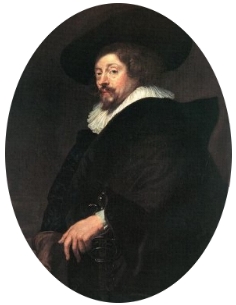  Peter Paul Rubens (1577-1640) was a prolific 17th century Flemish painter who worked in the Baroque style, which emphasized movement, colour and sensuality. He is perhaps best known for portraying full-figured voluptuous women. However, Rubens is also well known for his portraits, landscapes, and representations of mythical and religious themes.
Peter Paul Rubens (1577-1640) was a prolific 17th century Flemish painter who worked in the Baroque style, which emphasized movement, colour and sensuality. He is perhaps best known for portraying full-figured voluptuous women. However, Rubens is also well known for his portraits, landscapes, and representations of mythical and religious themes.Rubens visited Italy early in his career, where he was influenced by Italian Renaissance art. He also spent time in Spain. Many of his paintings were commissioned by others; these were mostly religious, historical or mythical subjects, and hunt scenes. He also painted portraits, especially of friends and of himself, and towards the end of his life painted several landscapes. Rubens was one of the last important artists to make use of wood as a backing for his paintings, although he used canvas as well. His works are of three kinds: those he painted completely by himself, those which he painted in part (usually hands and faces), and those he only supervised. As was common at the time, he oversaw a large studio with many apprentices and students, many of whom went on to become famous as well. Rubens was raised Catholic, and religion is a prominent theme in much of his work. His early training involved copying earlier artists' works; later his travels to Italy and Spain had a great deal to do with how he himself used colour and composition in his paintings. In Rome he was influenced by the art of Michelangelo, Raphael and Leonardo da Vinci; his later style was profoundly influenced by the Italian painter Titian. In 1610, he moved into a new house and studio that he designed, located in Antwerp. It contained his workshop, where he and his apprentices painted, and his personal art collection and library, both of which were very extensive. His most famous pupil was Anthony van Dyck, who soon became the leading Flemish portrait painter. Between 1627 and 1630, Rubens served as a diplomat between the courts of Spain and England. During this period Rubens was knighted twice, first in 1624 by Philip IV of Spain, and then by Charles I of England in 1630. He was also awarded an honourary Master of Arts degree from Cambridge University in 1629. An important painting from this period is the Allegory of Peace and War (1629). It illustrates Rubens' strong desire for peace, and was given to Charles I as a gift. In 1630, several years after the death of his first wife, the 53-year-old Rubens married 16-year-old Hélène Fourment. Hélène was the inspiration for many of the voluptuous figures in his paintings from the 1630s, including The Feast of Venus, The Three Gracesand The Judgment of Paris. An intimate portrait of her, Hélène Fourment in a Fur Wrap, is modelled after classical sculpture. Prior to the early 1900’s, for a woman to be eccessively plump was a symbol of beauty and fertility. For men, weight meant power. For both sexes, excess weight signified good health and wealth. Rubens himself believed that physical weakness could lead to spiritual weakness. He painted nudes and highlighted their well-rounded physical beauty, signifying goodness, temptation, desire, and fertility. His full-figured women were later to be called 'Rubenesque'. In 1635, Rubens bought an estate near Antwerp, where he spent the rest of his days, painting mostly landscapes. He died at the age of 63 in the year 1640. Selected Works by Peter Paul Rubens Place the cursor over each image to see its title. Then click to see a large version.
|